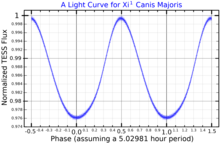Xi1 Canis Majoris
| Observation data J2000.0
| |
|---|---|
| Constellation | Canis Major |
| Right ascension | 06h 31m 51.36636s[1] |
| Declination | −23° 25′ 06.3181″[1] |
| Apparent magnitude (V) | 4.33 – 4.36[2] |
| Characteristics | |
| Spectral type | B1 III[3] |
| U−B color index | −0.98[4] |
| B−V color index | −0.24[4] |
| Variable type | β Cep[3] |
| Absolute magnitude (MV) | −3.86[6] |
| Details | |
Myr | |
| 06319-2325 | |
| Database references | |
| SIMBAD | data |
Xi1 Canis Majoris,
ξ1 Canis Majoris is a blue-white

The apparent magnitude varies from +4.33 to +4.36 with a period of 5.03 hours.[2] Its pulsations cause its radius to vary by 1.0% to 1.5%. At the same time its effective temperature by about 500 K above and below its mean temperature.[6]
ξ1 Canis Majoris has the longest known rotation period of any B class star, taking around 30 years to complete one revolution on its axis.[9] This is thought to be due to magnetic braking; ξ1 Canis Majoris has the strongest magnetic field of any β Cephei star and would be expected to spin down completely in around four million years. It also has the strongest and hardest X-ray emission of any β Cephei star.[6]
ξ1 Canis Majoris forms a naked eye pairing with
References
- ^ S2CID 18759600.
- ^ a b "International Variable Star Index". Retrieved 2018-11-13.
- ^ S2CID 17497112.
- ^ Bibcode:1966CoLPL...4...99J.
- Bibcode:1967IAUS...30...57E.
- ^ .
- S2CID 119257644.
- ^ "MAST: Barbara A. Mikulski Archive for Space Telescopes". Space Telescope Science Institute. Retrieved 20 August 2022.
- .
- doi:10.1086/323920.

